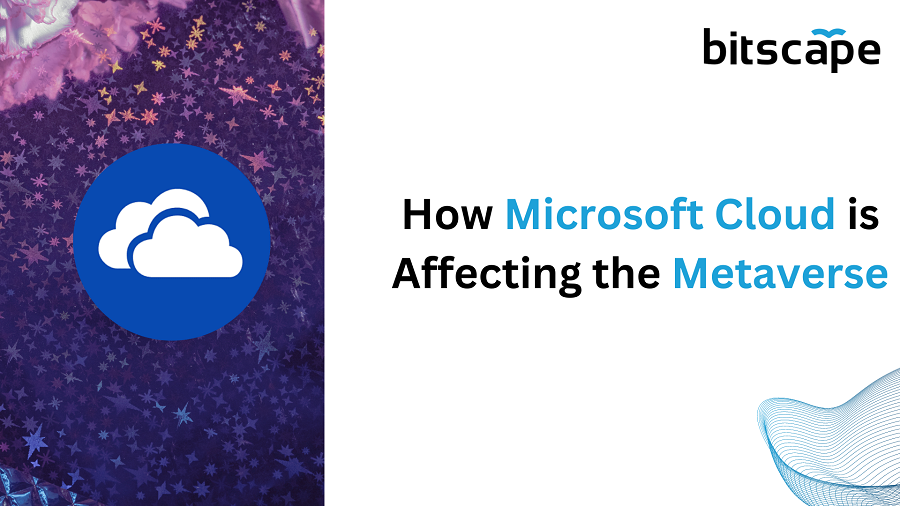How Microsoft Cloud is Affecting the Metaverse

The metaverse is being transformed by Microsoft Cloud. Cloud platforms are enabling cloud professionals to achieve the metaverse promise of a seamless digital environment. Microsoft, in particular, is leading the charge with its next big business transformation powered by cloud technology. Many analysts believe that this might be the next corporate revolution, integrating new technical developments such as AI and machine learning with cloud platforms to create an altogether new digital universe. However, one of the most difficult difficulties for Microsoft and other organisations striving to establish a safe virtual area for customers is security.
Microsoft Cloud is assisting in addressing this difficulty by providing alternative cloud providers, cloud infrastructure, and metaverse settings. Cloud computing allows enterprises to maintain track of their digital attack surface while employing dispersed edge infrastructure and edge computing management systems. With Microsoft’s service offerings, enterprises may now readily access computing power for the most demanding jobs. Furthermore, Microsoft Cloud provides solutions for identity and access management, allowing businesses to secure the security of their data in an ever-changing virtual environment. Microsoft Cloud makes it easy for organisations to explore new opportunities in the metaverse by offering a secure platform for apps operating across numerous clouds and devices.
Microsoft Azure is a premier cloud computing platform and public cloud provider, providing a full package of services that enable clients to design, deploy, and manage their own applications in the metaverse. Furthermore, Microsoft’s data streaming games service allows metaverse providers to stream their content on Microsoft Azure Consultant. This means companies may use general public cloud resources like computing and storage without having to set up a specialised architecture for each game.
Metaverses are being powered by Microsoft Cloud, which is altering how people interact with virtual worlds. Microsoft envisions the creation of strong metaverses that can deliver immersive experiences by combining Microsoft Points, IoT capabilities, and cloud resources. Corporate VP Mike Ybarra has been able to design new apps using this extensive collection of cloud-based technologies, which developers may employ to make distinctive metaverse experiences. With Microsoft Cloud, programmers can quickly and affordably deploy customised software on demand, enabling the creation of more intricate game ideas and potent metaverses. With the help of these tools, developers may produce incredibly immersive experiences without having to spend a lot of money on expensive gear or software.
Users may now construct dynamic digital places and hybrid worlds that blend the physical and digital worlds thanks to Microsoft Cloud’s array of technologies. As a result, digital twins have started to appear in a variety of industries, including the energy industry. Additionally, the Microsoft Cloud has made it possible for gadgets and people to connect via the internet, giving consumers access to augmented reality experiences and other urgent concerns.
In recent years, the idea of the metaverse—a shared virtual environment where users can interact with one another and digital things in what appears to be a real environment—has gained popularity. Microsoft is in a good position to contribute significantly to the creation and application of the metaverse thanks to its Azure cloud platform.
Azure’s capacity to offer the essential infrastructure for the building and hosting of virtual worlds is one way it is influencing the metaverse. Azure’s cloud computing capabilities make it possible to handle and store massive volumes of data effectively, which is essential for a metaverse to run smoothly. Additionally, Azure’s global network of data centres guarantees high availability and minimal latency for customers accessing the metaverse.
Microsoft also contributes to the metaverse through its collaborations with other businesses and institutions. As an illustration, Microsoft has joined the Open Metaverse Alliance (OMA), a coalition of businesses and institutions promoting the creation of an open and interoperable metaverse. Microsoft may contribute to the development of a metaverse that is accessible to and utilised by a variety of people and organisations by working with other OMA members.
The Azure Kinect DK sensor from Microsoft is also essential to the metaverse. The sensor may be used to take detailed 3D scans of actual people and items, which can subsequently be utilised to build lifelike digital replicas in the metaverse.
The growth of the metaverse is also being aided by Microsoft’s investment in Mixed Reality (MR) technology, such as HoloLens and Windows Mixed Reality. Through the employment of these technologies, users are able to interact with virtual things in a setting that appears to be real, giving them a more immersive experience of the metaverse.
In general, the development and use of the metaverse are being significantly aided by Microsoft’s Azure cloud platform and associated technologies. Microsoft is assisting in the development of a metaverse that is open, useful, and immersive for a variety of people and organisations by providing the required infrastructure and working with other businesses and organisations.
Although the metaverse is still in its infancy, there are numerous instances of the fundamental building components that I will discuss below.
The promotion of operational excellence
—————————–
Virtual product design is made possible by the ability to control 3D digital reproductions of the real environment, which also facilitates better supply chain and production procedures. In a digital environment, engineers and designers can work together to test novel ideas and procedures or find new efficiencies. Before they are ever built, Equinor, a pioneer in the energy revolution and the floating offshore wind industry, plans, manages, and maintains wind farms remotely. The integration of various sophisticated systems, distant, harsh conditions, and—not least—transmitting energy from offshore locations—are just a few of the considerable obstacles that wind farm developers must overcome. Equinor streamlines and expedites the design-build process by assembling data sets and testing wind farm concepts using computer simulations by building a virtual wind farm.
Increasing productivity and workplace safety
—————————–
Not just engineers and business analysts can benefit from the metaverse. Your workforce can be transformed by using interactive simulations and mixed reality tools, which will increase field workers’ and front-line employees’ training, support, and safety. Around 80% of workers globally do not work at a desk, particularly in industries like energy, manufacturing, healthcare, and agriculture. 1 Additionally, historically, this workforce has been under-equipped for digital technologies, and as a result, employment responsibilities and skill requirements are rapidly changing even as businesses struggle to fill open positions. Innovative businesses are empowering their workforce and supplying front-line staff with the digital tools they need to learn new skills, assist consumers, and resolve issues.
With Microsoft technology, the energy sector has a strong history of innovation to enhance operations and insights. Advanced analytics, connected devices, and AI are already being used by the energy sector to improve decision-making, monitor various activities, and enhance performance. Energy officials are now looking to the industrial metaverse to speed up the shift to cleaner energy while simultaneously improving efficiency and lowering risk.
Innovating for a future that is more sustainable
—————————–
Microsoft technologies are being used by the energy sector to innovate new ways of doing more with less. Today’s industrial metaverse is expanding prospects for businesses and workers alike while promoting the use of renewable energy sources. The metaverse contributes to accelerating the energy transition and our common journey toward net zero by empowering energy companies to more effectively and inexpensively create novel solutions, such as offshore wind farms. The Microsoft Data Platform and digital twin technology are assisting bp in locating opportunities to cut carbon emissions and model sophisticated new energy solutions. Whether it’s an engineer testing a new design or a salesperson making a bigger impression, immersive digital technology can help individuals stay safe and operate more effectively.
Microsoft is about to implement the cloud, which many analysts view as the next crucial corporate step in the development of the Metaverse. The business has committed to enable businesses to use the data to enhance Metaverse applications by making its cloud resources compatible with Metaverse experiences.
With its 365 productivity apps and, eventually, the Windows 365 suite available on the Meta Quest, Microsoft’s Meta cooperation might show the most immediate effects. The Meta Quest will be able to host a Windows Cloud PC thanks to the feature.
Furthermore, administrators will be able to manage devices and maintain the same level of identity security in virtual reality as they do with physical devices thanks to Microsoft Intune and Azure Active Directory for Meta Quest Pro and Meta Quest 2.
Making sure that bandwidth restrictions or internet connectivity issues don’t interfere with users’ ability to seamlessly enjoy the metaverse is one of the primary technical concerns that may occur as the metaverse grows.
Securing personal information that users create or store within the metaverse could be another difficulty. There is already solid reason to believe that personally identifiable information in the metaverse will need to be protected in the same manner that it is protected in a traditional cloud environment, even though it is unclear how regulators will define or handle personal information there.
Hybrid cloud architectures will likely become more popular as a method of hosting metaverse settings due to the demand for higher performance and the requirement for strong data security.




